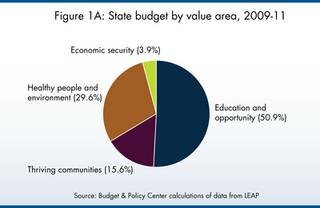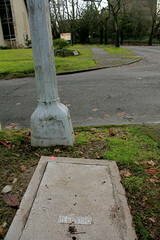Michael van Baker

About Michael van Baker:
Neighborhood: |
Capitol Hill |
Last Login: |
3 hours ago |
Joined: |
September 01, 2009 |
Profile viewed: |
2689 times |
Total Audience: |
361722 views |
| Editor & Publisher of The SunBreak | |
Storiesby Michael van Baker |
View by List | Grid |
"I hate my budget," was the literal money quote from Governor Gregoire, who went on to add, "in some places, I don't even think it's moral."
For the non-budget wonks among us, it's hard to square cutting $4.6 billion out of the 2011-13 two-year budget, so that it still totals a staggering $32.4 billion, with the scorched earth that's being reported: per the Seattle Times, say goodbye to the State Arts Commission and Tourism Office, the Basic Health Plan (an additional 66,000 without health insurance), the Disability Lifeline, state parks funding, and programs for gifted children and juvenile offenders. Here's an itemized list.
(Last Friday, the governor went on to suggest $1.1 billion in cuts from this biennial budget, starting early axe-work on the Basic Health Plan and Disability Lifeline, plus the Children's Health Program, state food stamp assistance, and education funding that supports poorer schools and smaller class sizes.)
 Washington Budget & Policy Center
Washington Budget & Policy Center
So what are we spending $32.4 billion on, exactly? That's the question I asked the Washington State Budget & Policy Center's Remy Trupin the day the state announced a $5.7 billion deficit. You might be surprised to learn that the state's prime directive, as it were, is to fund education. Over half of the state's budget goes to schools ($13.6 billion in 2007-09), higher education ($2.2 billion), and job training ($1.4 billion).
Because education is the state's top priority, that means that health and social services, environmental protection, and things like worker childcare assistance get cut first. But what sounds like a "reasonable" downsizing of the total budget, say six percent, is actually being repeatedly carved out of a much more limited area. Depending on how you slice it, you could be talking about cuts of 25 to 30 percent from budget sectors, and that's when whole programs suddenly go missing.
Some analysts think this "sharing the pain" is just and proper, but on Budget Schmudget (the Budget & Policy Center's blog), you learn that tax subsidies are harder to cut than funding. So while health insurance for the working poor goes away, we're still supporting "a $10 million per year sales tax exemption on nose jobs, face-lifts, and other cosmetic surgeries." The Budget Schmudgeteers argue that in addition to putting tax subsidies to a simple majority vote, legislators need to include expiration dates for these subsidies (currently almost 90 percent of tax subsidies on the books have the gift of immortality).
 Washington Budget & Policy Center
Washington Budget & Policy Center
Unfortunately (depending on your viewpoint), the reform that we actually see at the moment is the unconstitutional (I've argued) I-1053, requiring a supermajority vote for tax changes and such things as ferry fare hikes and road tolls. I-1053 and other legislative handcuffs are supposed to rein in "out of control" state spending--though the numbers show that state spending on public services, as a percentage of personal income, has declined since the late 1990s. (Not coincidentally, the state's population has grown 14 percent since 2000.)
All that I-1053 accomplishes is to put a club on the legislative steering wheel at precisely the moment you'd like more responsive taxing-and-spending handling.
Well, as is so often the case, much depends on your choice of metaphor. You hear a lot about "cutting the fat" or "cutting to the bone"--but what if it's really an amputation? After all, your foot makes up only some percentage of your body mass, and as a percentage, it seems like you'd hardly miss it. But my understanding is that if you do, in fact, cut off a foot, you really do notice a change out of proportion to its size. It was actually accomplishing quite a lot.
As the legislature looks at cutting program after program, you have to wonder if the only thing worse than the amount of money the state spends on public services is what we will end up paying if we don't have them.
 Palisade executive chef Chris Bryant popped out to introduce the menu
Palisade executive chef Chris Bryant popped out to introduce the menu
"While Palisade will always be a great special occasion restaurant," says Seattle Dining!, "the company wants it to be a spot where guests dine regularly--several times a month."
That's a bit of a reinvention, since the tonier Restaurants Unlimited location sits there by the marina at the base of the Magnolia bluffs, looking, with its expansive timbered interior (complete with salt water ponds), like it's about to make you pay through the nose (happily) for stuffing yourself to the gills with Pacific black tiger prawns, Dungeness crab, Maine lobster, New York steak, or Ellensburg rack of lamb.
So you can imagine our surprise when the SunBreak Lunch Team dropped in at Palisade as guests for a holiday get-together, and discovered something called the Magnolia Lunch that's worth the trip--a three-course lunch for just $15. (There's a First Seating dinner menu that's a prix fixe $29, also three courses.)
For starters, you have your choice of two salads or the soup of the day.
Seasonal Baby Leaf Lettuce Salad with green beans, cucumber, marjoram onions, baby tomatoes, in a vinaigrette
Choose between a hearts of Romaine salad (Caesar dressing, shaved Asiago), baby leaf lettuce salad, or the soup of the day. The spiced yam soup was delicious, not overbearingly sweet, and of a hearty consistency. Cold weather blahs, you've been yammed.
Spiced Yam Soup with candied pecans
For an entrée, you have a fresh fish selection (Washington sole at the moment), Dungeness crab BLTs, a Kobe burger (warm brie, pepper bacon), or chicken sateh.
Washington sole crusted with Parmesan and Asiago, with wild mushroom quinoa, asparagus, and tomato relish and lemon butter sauce
You are not likely to go wrong with any of these choices; and in fact you may end up returning solely for the chance to sample what you didn't last time. Also, let's hear it for portion control. This is a three-course lunch you can enjoy, and then return to the office after, without needing a nap.
Chicken Sateh, on coconut peanut rice noodles, with cucumber macadamia nut sweet chili salsa
The chicken sateh may seem like the "safe" choice, but the combination of flavors makes it a stand-out. For dessert? A trio of crème brulée or chocolate decadence cake.
That would be the Chocolate Decadence Cake, yes.
Trio of Crème Brulée (Grand Marnier, chocolate, vanilla bean)
I eat lunch nearly every single day of the year. Thinking back, this has to rate in my top five, just in terms of the quality of food and service. When you take the $15 price into account, it's easily number one.
 Photo courtesy Slightlynorth of The SunBreak Flickr pool
Photo courtesy Slightlynorth of The SunBreak Flickr pool
- Ballardite goes for win #4 on Jeopardy (My Ballard)
- Kimball crossing guard a jazz and race-relations pioneer (Beacon Hill Blog)
- Elliot Bay Plaza Sold for $54.25 Million (belltownpeople)
- 2 video views of the SPD shooting death of a Capitol Hill homeless regular (Capitol Hill Seattle)
- Pedestrian deaths disproportionately high in Central District (Central District News)
- Local Ferry Service Connects Eastlake to South Lake Union's FarmBoat (Eastlake Ave)
- The Stone Way Pit May Finally Be Turned Into…Something (Fremont Universe)
- Seattle Farm Coop seeks new warehouse (Blogging Georgetown)
- Senator Ed Murray to receive social justice award for improving the lives of LGBT families (My Green Lake)
- Breakdown of Farmers Market costs (Magnolia Voice)
- Read more about proposed Thornton Creek project (Maple Leaf Life)
- City updates multi-family code to allow for more variety in housing (PhinneyWood)
- Seattle Center to move ahead with Chihuly ‘glass house’ plans, KEXP studio and kids playground (Queen Anne View)
- SPD’s South Precinct Gets Fourth Commander in Four Years (Rainier Valley Post)
- The Seattle Times looks at Candy Cane Lane, past and present (Ravenna Blog)
- No permits? No problem for ‘Jiggles’ strip club (Roosiehood)
- Setting the Record Straight on the Columbia City Cinema (Southend Seattle)
- The Cold-Season Diet: Foods that strengthen your immune system (South Seattle Beacon)
- Public Art Coming to Mercer Corridor Project (The Southlake)
- Student robbed at gunpoint (U District Daily)
- Learn how Trophy makes those festive cupcakes (My Wallingford)
- Women of Wallingford (Wallyhood)
- Sewage spill cleaned up at Meadowbrook Pond (Wedgwood View)
- Newest moves in the court fight over ‘The Hole’ (West Seattle Blog)
- White Center in the TV spotlight on KING 5 – twice (White Center Now)
-
Are we missing your favorite Seattle neighborhood blog? Let us know in the comments.
 Alice Gosti and Devin McDermott in "Spaghetti Co." (Photo: Tim Summers)
Alice Gosti and Devin McDermott in "Spaghetti Co." (Photo: Tim Summers)
Near the beginning of Alice Gosti's Spaghetti Co. (Something just happened at 1:19 p.m.) a big bowl of pasta with red sauce is just that...a big bowl of pasta with red sauce, probably very tempting if you showed up to the Northwest Film Forum prior to dinner--it's part of the Forum's "Live at the Forum" performance series and ends with an 8 p.m. show tonight, December 18.
But by the end, the food has transubstantiated: the pasta is a doughy yeastiness in the air, a slippery cushion on the floor, the red sauce a gouache over the canvas of the body. While the people in the front row have had occasion to use their protective trash bags, the people in the second row are primed to duck the occasional rogue strand that heads their way.
The three striking young women (Alice Gosti, Laara Garcia, Devin McDermott) gathered so decorously around the table--bright red lipstick, fingernails, toenails--have buried their faces in their plates, poured wine in torrents, grabbed handfuls of pasta from the serving bowl, and worried at huge bites like dogs with a bone. Their chic little white dresses (by Mark Ferrin) are stained, and they have pasta in their hair and between their toes. While it sounds like Gallagher, it's surprisingly deliberate in pace, and nuanced, illuminating both the beauty and comedy to pasta unfurling in flight through the air, while capturing facet after facet of the social matrix that spans the table.
"Spaghetti Co." (Photo: Tim Summers)
If pressed to come up with a theme for the show, it'd be that, the gradual admixture of people and food until the new reality is permeated almost equally with both. What you see and hear is a combination of pantomime (silent but very active dinner table tableaux), mostly interpretive dance, and music from a the Johnny Astro band (two guitars, a bassist, and drums perched on a riser, who add Badalamenti-surf intermezzos to the evening).
Gosti's work is itself a mixture of the surreal and observational--there are moments that heighten a sense of giddy submersion of consciousness to eating (huge, grinning mouthfuls) and moments that despite their extremity (trampling out the pasta) feel weirdly like something you know from life. The piece is strongest when the table is a fourth member of the trio (at one point it bisects Gosti and McDermott who are lying underneath it, so that they look like Giant Doctor from Scrubs); when the trio break away for dance interludes, a bit of the tension and momentum dissipate because the table is where all the action is.
That said, McDermott's knees-tied stutter step deconstructs her dance into a habitual, compulsive form; when she drags her hand across her cheek from behind her head, it looks like an alien, red claw. Laara Garcia's straining, locked-ankle pose created a pair of feet that curled and grasped with sentient desire.
It's hard to say what this adds up to; Gosti isn't that interested in putting you in a position of judgment. If these women are feral and combative, they are also thoughtful and giving. If they eat and drink too much, they also eat and drink too little. I had to think for a while about why I felt the show reached completion--the scenes are tidal, repetitive, cumulative. Finally I realized it was that sense of the pasta transubstantiation, when it's been ground (by teeth, feet, hands) back into an elemental paste that contains the taste of family, home, belonging.
 Our friends at Newcastle were so delighted that we invited them to share BlogsGiving with us, they sent us (i.e., MvB) a DraughtKeg to say thanks. I had never seen one of these personal-sized kegs before, no doubt because I live in Washington (aka The Land that Alcohol Marketing Forgot Thanks to the Ninny-Nannies at the State Liquor Control Board).
Our friends at Newcastle were so delighted that we invited them to share BlogsGiving with us, they sent us (i.e., MvB) a DraughtKeg to say thanks. I had never seen one of these personal-sized kegs before, no doubt because I live in Washington (aka The Land that Alcohol Marketing Forgot Thanks to the Ninny-Nannies at the State Liquor Control Board).
The situation is this: It's a mini keg, holding five liters of Newcastle Brown Ale (B-, rates the Beer Advocate), that fits in your fridge and will keep for 30 days after tapping. Though really, if you enjoy beer, and it takes you 30 days to get through 10 pints, see a doctor. Two Sundays in a row I sat down to watch a Seahawks game with the roommate and *poof* it was empty.
There's a little bit of self-assembly (which I'll walk you through). I'm told it usually retails for about $23 (which makes those 10 pints pencil out at $2.30 per)--a good deal given the quality of the beer you get from the keg. It pours out with a good head (how much is up to your bartending skills and preference), and there's a fresh, airy, maltiness to the drink that's "just like at the bar."
If you haven't had Newcastle, it's an English import that is presently classing up the Heineken properties. It's a sweeter, easily drinkable brown ale, with caramels and a light malty nuttiness, but without any very aggressive elements in its flavor profile. The first tastes from the DraughtKeg introduce you to a fruitier top than you might be used to from a bottle.
The conspiracy is that you can't actually get a DraughtKeg here in Seattle yet, so I'm left to stare bitterly at the empty (which is fully recyclable, by the way, plastic and aluminum). It would be great if a few thousand of you would lobby Newcastle to add Seattle to their distribution. It's not going to replace the microbrews at the Hop Vine, but for home entertaining, it beats the hell out of a six-pack from the QFC. Plus, there's a certain satisfaction you get from opening your fridge and seeing a small keg in there. "Hello, DraughtKeg!" you think. Well, just look at that little beauty.
Here are The SunBreak's instructions for assembly of your DraughtKeg, just as soon as the distribution angle gets worked out.
1) You'll start with a small keg and two plastic pieces (not shown yet).
2) The spout just presses down onto a pressure-sensitive valve (like the top of a spray can). When you seat the spout, the pressure will release beer! Be ready for that, 'cause it's gonna shoot out. You might experiment by keeping your finger over the spout's end, or just having someone hold a glass there so not a drop is wasted.
3) The last piece is a little flip-top that snaps on and lets you press down easily on the spout. There are just two little pegs that let it pivot, and you can read the directions or you can just force 'em in there, which is what I did. It's not rocket science.
 Earlier this week, I posted about the growing concern that Colony Collapse Disorder may be driven in part by bees' exposure to clothianidin. Clothianidin is part of a class of systemic pesticides known as neonicotinoids, and they have been used widely across U.S. agriculture since the early to mid-1990s. "Systemic" refers to the fact that the pesticide pervades the plant it's applied to entirely, and so any troublesome insect that takes a bite of any part, from root to leaf, will be poisoned.
Earlier this week, I posted about the growing concern that Colony Collapse Disorder may be driven in part by bees' exposure to clothianidin. Clothianidin is part of a class of systemic pesticides known as neonicotinoids, and they have been used widely across U.S. agriculture since the early to mid-1990s. "Systemic" refers to the fact that the pesticide pervades the plant it's applied to entirely, and so any troublesome insect that takes a bite of any part, from root to leaf, will be poisoned.
When bees began dying off in large numbers in Europe, the precautionary principle was employed and neonicotinoid use was restricted or banned. (With interesting bee-bounceback results.) In the U.S., where the EPA professes to have no conclusive reason to act, beekeepers have been left to enforce their own boycott.
A SunBreak reader alerted me to the work of Dutch toxicologist Henk Tennekes (not the climate change impact skeptic), and his research that concludes honey bees and birds can scarcely help being affected by neonicotinoids. "Improper" use of a pesticide is one thing, but his 72-page, heavily footnoted scientific treatise, A Disaster in the Making, demonstrates that this class of pesticides is unsafe in any hands.
"It is a serious ecological report rather than a book for general readers," warns the website, but a serious ecological report is exactly what is required. Tennekes explains in this podcast that neonicotinoids are persistent in the environment in two ways: first, they can be active for months in plants they're applied to, but more importantly, their neurological effects (a dérangement de tout les bee sens) may be irreversible.
Neonicotinoid insecticides act by causing virtually irreversible blockage of postsynaptic nicotinergic acetylcholine receptors (nAChRs) in the central nervous system of insects. The damage is cumulative, and with every exposure more receptors are blocked. In fact, there may not be a safe level of exposure.
That specific effect is what makes beekeepers nervous, because Colony Collapse Disorder (unlike other bee epidemics) doesn't leave you with a hive full of dead bees; it leaves you with an empty hive. The disorientation that these pesticides provoke seems like a smoking gun, when also tied to a lack of grooming that would allow mites and funguses to flourish. Tennekes notes that if initial contact is not enough to kill (though it often is), the effects will accrete until the insect or earthworm bites the dust.
That dust is also compromised. Writes Tennekes: "The second catastrophic disadvantage of neonicotinoids is their potential to leach from soils. [...] The excessive imidacloprid levels noted in surface water of western Dutch provinces with intensive agriculture have already been associated with insect decline and a dramatic decline of common grassland birds." Birds, you'll recall, feed on insects. If swaths of seemingly productive farmland are in fact food deserts, it's Rachel Carson's Silent Spring revisited, says Hennekes. (And U.S. bird population would not seem to be immune.)
 The Capitol Hill streetlight/shock device (Photo: CHS)
The Capitol Hill streetlight/shock device (Photo: CHS)
"We discovered that the original installation in 2006 did not include proper grounding of the four lights," said superintendent Jorge Carrasco. "We want the public to be assured that this was an isolated incident."
It was true that, so far as anyone knew, this was the first dog to be killed by streetlight electrocution. But...City Light couldn't really assure anyone, in the actual sense of the word, that there was no further danger because they needed to inspect other streetlights first.
Once they did, a troubling trend emerged. They found another streetlight "leaking" unsafe levels of electricity in High Point. That's not the troubling part per se; that would come when the Carrasco, the "city's highest-paid executive" called the Queen Anne and High Point problems "two isolated incidents."
As CHS reported, City Light soon found three more dangerous light poles discharging electricity--60 to 105 volts. Perhaps more upsettingly, City Light didn't actually find these poles--a contractor did, who took it upon himself to go check on what he estimated would be trouble spots due to aging infrastructure. Two of the poles were 30 to 40 years old, and the third was even older.
Meanwhile, City Light had inspected some 270 light poles without finding any problems in "all of the streetlights at the High Point Development (170) and all of the streetlights at the GreenBridge Development (which actually is in King County, but a part of our service territory - there are 100)."
On Wednesday, a sixth pole was found in Greenwood, discharging "120 volts, enough to kill," reported the Seattlepi.com. So far from being an "isolated incident," streetlights that could electrocute you have been found in Queen Anne, Greenwood, Capitol Hill, Central District, and First Hill.
In total, there are 20,000 light poles and 10,000 streetlight vault covers to check on, so this could take a while. You've been deputized by City Light to report any odd behavior from streetlights in your neighborhood:
Get in touch with us immediately! Call us (206) 684-7056--or go online to: www.seattle.gov/light/streetlights
Some things for people to look for:
1) A streetlight that is on during the day
2) A streetlight that "flickers" at night
3) Any sense of "tingling" when near a metal streetlight pole or a metal groundcover plate
 Of course, the problem could also be the model Pacific Place shopper (pictured) won't fit beneath the low ceilings of a parking garage.
Of course, the problem could also be the model Pacific Place shopper (pictured) won't fit beneath the low ceilings of a parking garage.
I've been using Occam's Razor a lot lately--if I could, I'd shave with it and save a ton of money--so I wonder if a consultant is needed. The thing is, the parking garage worked like a charm for the first eight to ten years of its existence. Even though it was priced below market rate, at $2 per hour, it made up enough in volume (it parks 1,200) to pay for its debt and operations.
It's just that more recently, between 2004 and 2009, use has fallen almost 18 percent, says the Times' Emily Heffter. In 2008, it failed to make enough money to pay for itself. (By city ordinance, it's forbidden to make a profit or build up substantial cash reserves.) In tandem with use falling, the parking rate there has increased to $5 per hour.
It's as if, in a microeconomic sense, there's some indefinable but real-world relationship between the cost of parking and the number of people willing to park there--while at the same time, there's the macroeconomic effect of a major economic downturn having taken place.
To rejigger an old expression, "If it wasn't broke before, undo whatever you did to fix it." In this case, that would seem to indicate rolling back prices. (This doesn't mean you should lower on-street metered parking rates; they are being used so much they're never open, which indicates that most people find them a good deal, comparatively.)
People profess to be puzzled that, in terms of the competitive arena, Pacific Place's decline in usage has been larger than neighboring garages. Here is my hypothesis. Pacific Place is the only city-owned parking garage allowed simply to "break even" downtown. While its prices beat everyone else, it could siphon off business from all the other market-rate enterprises that actually attempt to make money--that is, it had a much broader pool of potential customers than people shopping at Pacific Place. When its price increases moved it into competition with everyone else, it began to lose business to every other parking option.
 Bloomberg Businessweek has assembled one of those link-bait "Best Blank to Blank in the U.S." lists ("America's Best, Affordable Places to Raise Kids"), which are like...not crack, what's something more credible...um...like bacon cheeseburgers to us, so here you are. As it turns out, the kid-friendliest di tutti citta in the state may be, for our local readers, a shocker.
Bloomberg Businessweek has assembled one of those link-bait "Best Blank to Blank in the U.S." lists ("America's Best, Affordable Places to Raise Kids"), which are like...not crack, what's something more credible...um...like bacon cheeseburgers to us, so here you are. As it turns out, the kid-friendliest di tutti citta in the state may be, for our local readers, a shocker.
The Best Place to Raise Your Kids in Washington state is...Pullman. Ready for the next jab? The runner-up is West Richland. Now, this may not be as remarkable a west-side shut-out as it appears, as to judge from the blurb, the key criteria were "bordering Idaho," "wheat fields," "geographic marvels," and "high WASL scores." Also, "Pullman is a seat of learning and home to Washington State University."
Obviously not every city can be home to WSU, and there's no arguing the wheat field gap with our eastern neighbors. Bloomberg didn't even mention the Giant Palouse earthworm, which we have absolutely no answer to, and which you have to know is like...oh god, not crack again...uh...well, it's like any giant weird creature to kids.
In all seriousness, Bloomberg says they wanted to focus on smaller towns and cities, and not large, urban areas. I suppose that's nice and Norman Rockwell, but really? It seems a substantial assumption that kids are better off getting run over by a wheat combine than the express bus to downtown. Have you ever looked at the kinds of accidents farm kids are prone to? It's gruesome, and nearly always involves losing an arm to a machine. Still, it's a gut-check to realize that Eastern Washington still came out in front on the following:
The rankings put the most weight on school performance and the number of schools, crime statistics, and cost of living. Other factors included job growth, air quality, ethnic diversity, and access to recreational amenities (within the county), such as parks, zoos, theaters, and museums.
 Examples of Sunergy Systems residential installations
Examples of Sunergy Systems residential installations
NW SEED hopes to roll out the Solarize program to two more neighborhoods in 2011, so let the online lobbying begin.
Solarize Queen Anne includes a registration process to determine which Queen Anne residents are interested in learning about solar power, workshops, and free site assessment from Ballard's Sunergy Systems to see if solar power can light up your life effectively. Best case, you have a roof with tons of southern exposure, and that can handle a solar installation on top.
What makes Solarize Queen Anne different than simply asking Sunergy Systems to install a few panels on your roof is that they're leveraging community interest to make discounted bulk buys of materials. So in addition to a Federal Residential Solar Tax Credit, a Washington State Renewable Energy Production Incentive, and a Washington State sales tax exemption, participants will see bulk purchase savings.
You may have questions about solar energy in Seattle. It's a little counterintuitive, but keep in mind that while there was actual sunshine this afternoon, in mid-December, where you might really send the meter spinning backwards (not that they do, anymore, it's just an expression) is during our long summer days. And if you're among the 500 people who have been without power all day, you might really appreciate the benefits to having your own power source.

